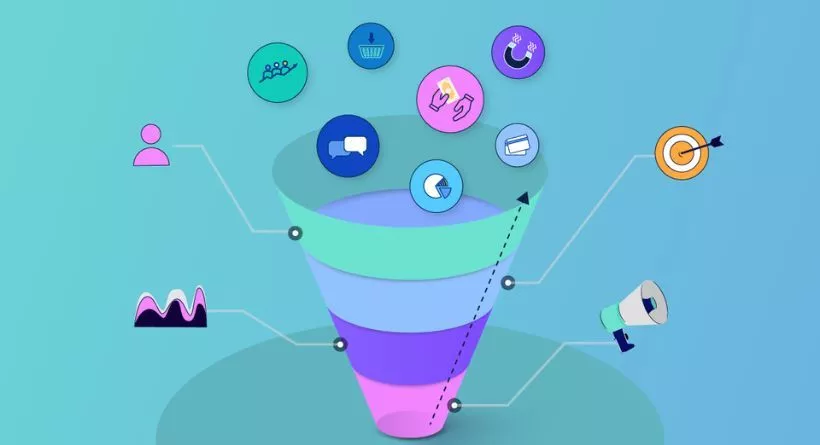Are you struggling to turn your website traffic into conversions? Don’t worry, you’re not alone. With only a fraction of your visitors actually taking action, it’s crucial to optimize your conversion rate to increase profits. Luckily, there’s a solution: funnel analysis.
By analyzing your website’s funnel, you can identify the exact point where visitors are dropping off and take the necessary steps to boost conversions. Whether it’s a subscriber clicking on a link, joining your newsletter, or making a purchase, funnel analysis can help you improve your website’s performance.
In this article, we’ll walk you through the process of conducting a funnel analysis to help you maximize your conversion rate. Don’t let potential customers slip away – let’s dive into funnel analysis and start boosting your conversions today!
What is funnel analysis?
Visualizing the stages of the consumer journey is critical for understanding and optimizing your sales process. This is where funnels come in, providing an intuitive and effective way to map out the different stages of your customer’s journey. By conducting a thorough funnel analysis, you can track and analyze the actions taken by users at each stage of the funnel, identifying where they enter and exit the funnel.
To conduct an effective funnel analysis, it’s crucial to gather and analyze relevant data from various sources. Popular data sources for analysis include Google Analytics, heatmaps, and user recordings, among others.
By combining data from these sources, you can gain deeper insights into user behavior and identify potential issues. This, in turn, allows you to develop and test hypotheses using conversion rate optimization (CRO) strategies, such as A/B or multivariate testing.
Through continuous monitoring and tweaking of your funnel, you can gradually enhance your conversion rates across the board. With careful analysis and optimization of the data available, you can take your funnel performance to the next level.
The type of funnel being analyzed has a direct impact on the deliverables of the analysis. The following are some of the key actions involved in completing a comprehensive funnel analysis:
Identifying high-traffic, high-exit pages: Utilizing a funnel mapping tool, you can pinpoint the pages with the highest drop-off and conversion rates. This information provides insights into when and where visitors are leaving your site, enabling you to take corrective measures.
Determining sources of high-quality traffic: Funnel analysis helps you identify the sources of your high-converting website traffic, allowing you to leverage these channels for optimal results.
Assisting decision-making: Funnel reports provide actionable data to aid decision-making. Highlighting areas of concern, such as drop-offs or poor conversion rates, can motivate your team to respond.
Effective funnel analysis is vital for improving the returns on your sales and marketing efforts. By identifying and addressing issues through funnel analysis, you can take corrective actions that will ultimately help grow your business. Now that you understand the significance of funnel analysis, let’s dive into how you can conduct one effectively.
Steps to determine why potential customers are leaving your funnel
Let’s follow the steps:
Map the ideal buying process
Effective funnel analysis starts with creating a comprehensive funnel map that outlines all the stages and variables you will be tracking. This enables you to identify areas where you can optimize and improve the customer journey.
For instance, you may want to map out the ideal path a customer should take through the research and decision-making process before making a conversion. Alternatively, you might want to analyze how your sales team finds and develops leads through email prospecting.
By creating customer journey maps, you can establish campaign goals and gain insights into how prospects and customers interact with your brand. These insights can inform your optimization efforts and help you create a more engaging and effective customer experience. We’ll delve deeper into this topic in the following sections.
Monitor KPIs
When it comes to monitoring your funnel’s health, the first step is to select the right key performance indicators (KPIs). But how do you determine which KPIs to track?
Here are some of the most commonly monitored KPIs:
- Lead generation: The number of leads generated within a specific timeframe.
- Lead attrition: The percentage of leads lost during the sales process.
- Time to conversion: The amount of time it takes a lead to convert into a paying customer.
- Sales operation metrics: The effectiveness of your sales team and the efficiency of your sales process.
- Customer lifetime value: The total value a customer brings to your business over their lifetime.
Of course, there are many more KPIs you can track depending on your business and your funnel. Once you have identified your critical KPIs, it’s important to regularly monitor them to assess the overall health of your pipeline and identify any areas for improvement.
By keeping a close eye on your funnel KPIs and making adjustments as needed, you can optimize your sales and marketing efforts and achieve greater success for your business.
Understand user behavior
Understanding user behavior is crucial in optimizing your marketing funnel. With user behavior analytics, you can monitor and identify pain points in your customers’ experiences. To gather relevant data, you can use various tools like Google Analytics and heatmap software. These tools can provide valuable insights into how visitors interact with your website and which elements they engage with the most. You can also use data points from your CRM, such as email open rates and click-through rates, to gain a deeper understanding of user behavior. The more insights you can gather, the better equipped you are to identify issues and develop solutions that reduce leaks in your funnel and improve conversions.
Identify problems at each funnel stage
To enhance your funnel performance, it’s essential to merge the KPI insights with relevant data gathered at each funnel stage. By doing so, you can detect problems and optimize your funnel performance effectively. Once you have a list of problems, prioritize them using a tool like the Action Priority Matrix to determine which tasks should be completed first for optimal results.
Once you have identified the problems in your marketing funnel through your funnel analysis, prioritizing your tasks based on their importance is crucial. This task list will be the result of your funnel analysis, helping you pinpoint areas for improvement.
There are several tools that can help you identify these problem areas. For instance, if you notice a high drop-off rate at a page with a submission form, you may need to scrutinize the form to find out what’s causing the issue. Conducting a micro-funnel analysis of the form could be useful in identifying the problem and making the necessary adjustments to improve your conversion rates.
To perform a micro funnel analysis, leverage the Funnel Visualization Report on Google Analytics or check out a relevant article. Identifying major drop-off points throughout your funnel and analyzing them can lead to an improvement in your overall conversion rate. Keep in mind that this process is iterative, so make changes, review the results, and take the necessary action accordingly to refine your funnel.
Use funnel comparison
When conducting a funnel analysis, it can be beneficial to compare your funnel with that of a competitor to gain insights into their approach to generating conversions. While you may not be able to obtain data on the conversion rate at each stage of the funnel, a funnel comparison can still provide valuable insights into your competitor’s tactics and potential areas for improvement in your own funnel. Keep in mind that a funnel comparison is just one aspect of your overall funnel analysis and should be used in combination with other tools and data points to make informed decisions about your sales and marketing efforts.
Final Thoughts
Boosting your business can be as simple as enhancing your conversion rates within your current marketing funnels. This article offers a comprehensive framework for achieving this goal through effective funnel analysis.
It’s essential to regularly review your marketing funnels, beginning with mapping the ideal buying process, monitoring key performance indicators, and gaining insights into user behavior.
By doing so, you’ll be able to identify and address issues at each stage of your funnel. For a more thorough analysis, don’t forget to compare your funnels with those of competitors to generate more leads and improve your overall conversion rates.








